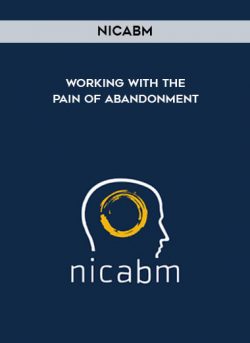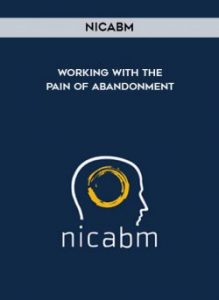Courses Infomation
Working with Abandonment by NICABM
Working with Abandonment by NICABM
**More information:
Description
Working with Abandonment: 26 Top Experts Share the Latest Strategies to Help Clients Heal
Being abandoned hurts. In the moment, it can feel like you can’t breathe and that life is about to end. And then comes the painful sensations that ripple through the body and fill you with paralyzing panic.
When this happens to a client, they can become fearful of ever experiencing abandonment again. Problem is, they can then develop harmful coping strategies that not only create more pain, but put them at even greater risk of being rejected.
So how do we work with the desperate behavior and hair-trigger nervous system that can make abandonment a self-fulfilling prophecy?
We turned to the world’s 26 top experts to hear how they work with clients who have been abandoned. Here are the latest strategies that you can start using in your work today.
Working with the Pain of Abandonment
How to Work with Clients Who Are Hypersensitive to Rejection
Peter Levine, PhD Ron Siegel, PsyD
Judson Brewer, MD, PhD Melanie Greenberg, PhD
- The specific neural pattern that fuels a fear of abandonment
- One way to help clients shift out of a rejection-oriented mindset
- How to work with a client’s panic when being rejected
Key Strategies for Working with Abandonment and Trauma
Bessel van der Kolk, MD Peter Levine, PhD
Kelly McGonigal, PhD Resmaa Menakem, MSW, LICSW, SEP
Melanie Greenberg, PhD
- How PTSD can lead to powerful brain schemas that invite rejection from others
- One practice to help clients with panic disorder regulate their body when triggered by abandonment
- How trauma-informed neurofeedback can neutralize reactivity to an experience of rejection
How to Approach Shame That Drives a Fear of Rejection
Dan Siegel, MD
- How the ruminating brain can lock clients into ambivalent relationships that invite shame
- How to work with clients whose sense of defectiveness fuels a fear of abandonment
How to Recondition a Nervous System Damaged by Abandonment
Stephen Porges, PhD Deb Dana, LCSW
- How abandonment leaves a deep tracing on the nervous system (and what this means for treatment)
- Why the nervous system will often sabotage offers to co-regulate
- How to help a client’s nervous system tolerate ruptures in a relationship
How to Read the Abandonment Story Your Client’s Body Is Telling
Pat Ogden, PhD Bonnie Goldstein, PhD Deb Dana, LCSW
- How to recognize possible signs of early life abandonment in your client’s body
- How a client’s physiology can reveal the way they’re managing a fear of abandonment
Ways to Change Fearful Behavior That Sets a Client Up for Further Abandonment
Pat Ogden, PhD Melanie Greenberg, PhD Ron Siegel, PsyD
Donald Meichenbaum, PhD Terry Real, MSW, LICSW
- Two specific ways a client’s fear of abandonment can become a self-fulfilling prophecy
- How to reframe a client’s neediness to make it an ally in their healing
- How to help a client stay regulated when their partner rejects their needs
How to Help Clients Stop Sacrificing Their Boundaries to Avoid Being Abandoned
Joan Borysenko, PhD Kelly McGonigal, PhD Ron Siegel, PsyD
Judson Brewer, MD, PhD Melanie Greenberg, PhD Pat Ogden, PhD
- The addiction model that leads a client to soften their boundaries (and how to change it)
- The painful reason why some clients will gamble away their principles in a relationship
- Two practical ways to help clients shore up their personal boundaries
A 3-Step Strategy to Expand a Client’s Tolerance of Rejection
Steven Hayes, PhD Kelly McGonigal, PhD
- How to help clients engage their fear of abandonment without getting overwhelmed
- How to adjust your treatment of abandonment when the client dissociates
- A compassionate strategy to help clients break a paralyzing fear of abandonment
How to Treat A Fear of Abandonment Linked to Betrayal
Shelly Harrell, PhD Richard Schwartz, PhD Stan Tatkin, PsyD, MFT
- One way to reduce the stigma and humiliation a client attaches to their experience of betrayal
- The damaging way clients often approach decisions when they fear loss
What is HYPNOSIS – NLP?
Neuro-linguistic programming (NLP) is a technique used to provide clients with the tools to overcome certain life obstacles. NLP is in short, a way of helping people help themselves to reach a state of excellence, happiness and peace of mind.
NLP is a learning model devised by two American academics (Dr Richard Bandler and John Grinder) in the early 70s, who were fascinated by the relationship between language behaviour and excellence. They believed that by analysing the unconscious linguistic techniques used by successful people, they could produce ‘a recipe for excellence’ in which other people could consciously learn to apply said ‘successful techniques’.
What is NLP?
NLP stands for neuro-linguistic programming.
Neuro – All of our experience is gained from the neurological processes that govern our five senses: taste, touch, smell, sight and sound.
Linguistic – We make sense of these experiences through a set of filters, including language. The language we use can also affect the way we experience things.
Programming – This is a way of controlling the outcome of something. A person can use NLP to ‘predetermine excellence’ by adjusting the language we use.
To break it down, the science aspect is the process of extracting and learning the techniques. The art aspect is the act of applying the techniques to our own lives.
There are four ways NLP techniques are most commonly used:
to teach effective communication
to ensure continual personal development
to enhance learning
to encourage a greater enjoyment in life
NLP is used to teach us how changing our perception of the world can lead us to adjust and adapt our behaviours to live the life we want.
NLP and hypnotherapy
Hypnotherapists aim to induce a relaxed and receptive state (trance) in their clients in order to access the subconscious. Many of the obstacles that prohibit or limit a person’s experiences are deeply embedded in the subconscious, so by accessing the thought processes that usually remain hidden, hypnotherapists can work with clients to change the restrictive thought pattern and make room for positive development.
An NLP practitioner will look at your attitude, your language and how you use it, your understanding of relationships and your ability to build rapport, as well as the physical and emotional states that are best for accomplishing a task. Effective communication and perception of others and ourselves, will also be key focuses. All of these will be analysed and examined by the professional, so that a strategy for improving understanding, motivation, learning and memory can be formed.
Many hypnotherapists train in NLP to help improve their ability to communicate more effectively with their clients, as well as to help their clients communicate more effectively with themselves.
Salepage : Working with Abandonment by NICABM
About Author
NICABM
The National Institute for the Clinical Application of Behavioral Medicine is a pioneer and leader in the field of mind-body-spirit medicine. As a provider of continuing education for health and mental health care professionals for over 20 years, NICABM is at the forefront of developing and delivering programs with “take home” ideas, immediately adaptable for practitioners to use with their patients.
More From Categories : HYPNOSIS – NLP
Curriculum:
196:” “;}}
“;}}











![Peter Titus - Create Your Own Automated Stock Trading Robot In EXCEL! [39 Video (MP4) + 2 Document (HTML)]](https://crablib.info/wp-content/uploads/2021/02/Peter-Titus-Create-Your-Own-Automated-Stock-Trading-Robot-In-EXCEL-39-Video-MP4-2-Document-HTML.jpg)























Reviews
There are no reviews yet.